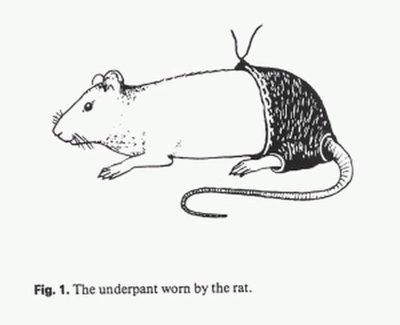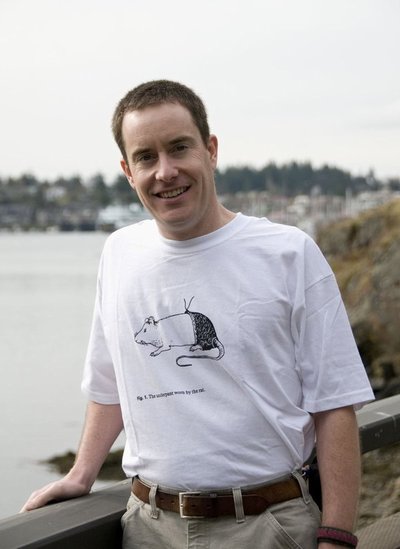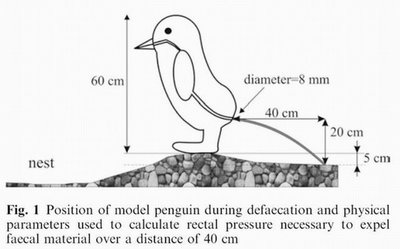April 9, 2009
Rats’ underpants bring about human t-shirts, with a few laughs along the way
What do a rat wearing underpants, some marine biologists and a defecating penguin have in common? (Please see Fig. 1.)
If your first thought is “t-shirts!” then congratulations, your brain must be wired the same odd way as that of Michael “Moose” O’Donnell, a post-doc at the UW’s Friday Harbor Labs. Outside of work, he sells both images on t-shirts under the marketing title “Fig. 1 wear.”
What exactly is Fig. 1 wear? O’Donnell says it all started when he first saw the rodent illustration and its drolly understated caption, “The underpant worn by the rat.”
“I was a grad student at the Stanford Marine Lab in Monterey. And a post-doc from the UW Zoology Department (Chris Harley, now a professor at the University of British Columbia) actually found it on a refrigerator at Harvard. So he brought it into our lab and we thought it was so funny we downloaded the paper in which the illustration appeared.”
The two learned that the apparently serious research was the work of an Egyptian urologist, now dead, who was testing the effects of various textiles on sexual performance — in rats and in humans, too. (Polyester, it seems, is the least conducive to sexual success. No surprise there.)
“We definitely were not laughing with this guy, we were laughing at him,” O’Donnell admits. “It was very clear he was of the opinion that he was one of the real leaders of the field of erectile dysfunction in rats.”
The look of the rat itself — with his tail coming through his tailored, Stuart Little-like trousers — only made things funnier: “We were talking about (how) this is really everything absurd in science getting summed up in the silly little smile on the rat’s face,” O’Donnell said. “If people are doing this kind of science and not thinking it’s funny, then we have to think it’s funny for them.”
The t-shirt angle happened pretty spontaneously, he said. “I just ran down to the local t-shirt shop and got a couple of shirts made.” He sold them straightaway, so he had another 100 made, and more since.
After that, he started keeping an eye out for research whose “Fig. 1” illustration is funny enough for a t-shirt. And it has to be a real Fig. 1 in real research, he said. “I’m willing to laugh at a Fig. 2, but I’m not making a shirt out of it!”
People occasionally send him ideas for more Fig. 1 t-shirts, but “most of them sort of miss the point,” he said. “In most, the Fig. 1 is just plain weird. I think, ‘I wouldn’t want to wear that on a shirt.'”
And then came the defecating penguin. “The penguin came across my desk one day and immediately I was laughing hard enough I thought, OK, let’s make t-shirts!” This one is a little different, O’Donnell said, “because I’m sure the author of the study is laughing too.”
He sells each for $15 and said he isn’t exactly getting rich. “I’ve gotten rid of about 200 — probably sold about half and I’ve given the rest away. I doubt if I’ve ever broken even.”
Fig. 1 wear is a minor sidelight for O’Donnell, whose professional work at the Friday Harbor Labs spans a variety of marine ecology research. In one project he is studying how intertidal organisms respond to temperature changes in their environment. In another he studies biological effects of changes in ocean pH. He moved to the UW from the University of California at Santa Barbara about six months ago.
The absurdity at the heart of Fig. 1 wear is continued on its Web site, which O’Donnell said was created by Luke Miller, a fellow Stanford grad student. It’s at www.moosecraft.org/fig1. “They said the world wasn’t ready …” the site warns. “We tended to agree … But we did it anyways…”
It goes on to explain that Fig. 1 wear was founded by “people with too much time on their hands, people with an odd fascination for obscure science … Fig. 1 wear tends to be obtuse on purpose.”
Michael “Moose” O’Donnell — nicknamed thus because “I was a fat baby,” he said — remains open to finding new Fig. 1 wear ideas, but admits “It has sort of dried up. I maybe get one a year now and they are rarely funny enough to do anything with. I’d love to find another Fig. 1 that’s funny enough.”
He said, “Every now and then someone will buy a shirt from the Web site — I have no idea where they find it.
“I keep waiting for the day when I run into someone wearing a shirt and they rave about how funny it is.”



